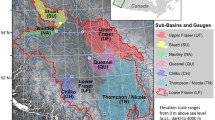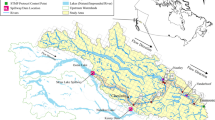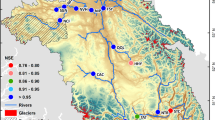Abstract
Climate change in the Pacific Northwest and in particular, the Salmon River Basin (SRB), is expected to bring about 3–5 °C rise in temperatures and an 8 % increase in precipitation. In order to assess the impacts due to these changes at the basin scale, this study employed an improved version of Variable Infiltration Capacity (VIC) model, which includes a parallel version of VIC combined with a comprehensive parameter estimation technique, Shuffled Complex Evolution (SCE) to estimate the streamflow and other water balance components. Our calibration (1955–1975) and validation (1976–1999) of the model at the outlet of the basin, White Bird, resulted in an r2 value of 0.94 which was considered satisfactory. Subsequent center of timing analysis showed that a gradual advancement of snowmelt induced-peak flow advancing by about 10 days in the future. Historically, the flows have shown a general decline in the basin, and in the future while the magnitudes might not be greatly affected, decreasing runoff of about 3 % over the next 90 years could be expected and timing of peak flow would shift by approximately 10 days. Also, a significant reduction of snow water equivalent up to 25 %, increased evapotranspiration up to 14 %, and decreased soil moisture storages of about 2 % is predicted by the model. A steady decline in SWE/P from the majority of climate model projections for the basin was also evident. Thus, the earlier snowmelt, decreasing soil moisture and increased evapotranspiration collectively implied the potential to trigger drought in the basin and could affect the quality of aquatic habitats and their spawning and a detailed investigation on these impacts is warranted.











Similar content being viewed by others

References
Abatzoglou J (2011) Influence of the PNA on declining mountain snowpack in the Western United States. Int J Climatol 31:1135–1142
Adam JC, Hamlet AF, Lettenmaier DP (2009) Implications of global climate change for snowmelt hydrology in the 21st century. Hydrol Process 23(7):962–972
Adbulla FA, Lettenmaier DP (1997) Application of regional parameter estimation schemes to simulate the water balance of a large continental river. J Hydrol 197:258–285
Barnett TP, Adam JC, Lettenmaier DP (2005) Potential impacts of a warming climate on water availability in snow-dominated regions. Nature 438:303. doi:10.1038/nature04141
Cherkauer KA, Lettenmaier DP (2003) Simulation of spatial variability in snow and frozen soil field. J Geophy Res 108(D22):8858. doi:10.1029/2003JD003575
Cuo L, Beyene TK, Voisin N, Su F, Lettenmaier DP, Alberti M, Richey JE (2011) Effects of mid-twenty-first century climate and land cover change on hydrology of Puget Sound basin, Washington. Hydrol Process 25:1729–1753
Daly C, Neilson RP, Phillips DL (1994) A statistical–topographic model for mapping climatological precipitation over mountainous terrain. J Appl Meteor 33:140–158
Daly C, Taylor GH, Gibson WP (1997) The PRISM approach to mapping precipitation and temperature. Preprints, 10th conference on applied climatology, Reno, NV, American Meteorological Society, pp 10–12
Duan Q, Gupta VK, Sorooshian S (1993) A shuffled complex evolution approach for effective and efficient global minimization. J Optim Theory Appl 76:501–521
Fowler HJ, Blenkinsop S, Tebaldi C (2007) Linking climate change modeling to impact studies: recent advances in downscaling techniques for hydrological modeling. Int J Climatol 27:1547–1578. doi:10.1002/joc.1556
Graham LP, Hagemann S, Jaun S, Beniston M (2007a) On interpreting hydrologic change from regional climate models. Clim Change 81:97–122. doi:10.1007/s10584-006-9217-0
Graham LP, Andreasson J, Carlsson B (2007b) Assessing climate change impacts on hydrology from an ensemble of regional climate models, model scales and linking methods—a case study on the Lule River Basin. Clim Change 81:293–307
Hamlet AF (2011) Assessing water resources adaptive capacity to climate change impacts in the Pacific Northwest Region of North America. Hydrol Earth Syst Sci 15:1427–1443
Hamlet AF, Mote PW, Clark MP, Lettenmaier DP (2007) 20th century trends in runoff, evapotranspiration, and soil moisture in the Western U.S. J Climate 20(8):1468–1486
Hoekema D, Sridhar V (2011) Relating climatic attributes and water resources allocation: a study using surface water supply and soil moisture indices in the Snake River basin, Idaho. Water Resour Res. doi:10.1029/2010WR009697,47,W07536
Jin X, Sridhar V (2012) Impacts of climate change on hydrology and water resources in the Boise and Spokane River Basins. J Am Water Res Assoc 48(2):197–220. doi:10.1111/j.1752-1688.2011.00605.x
Jung IW, Chang H (2011a) Climate change impacts on spatial patterns in drought risk in the Willamette River Basin, Oregon, USA. Theor Appl Climatol. doi:10.1007/s00704-011-0531-8
Jung IW, Chang H (2011b) Assessment of future runoff trends under multiple climate change scenarios in the Willamette River Basin, Oregon, USA. Hydrol Process 25:258–277
Jung IW, Chang H, Moradkhani H (2011) Quantifying uncertainty in urban flooding analysis considering hydro-climatic projection and urban development effects. Hydrol Earth Syst Sci 15:617–633
Kalnay E et al (1996) The NCEP/NCAR 40-year reanalysis project. Bull Am Meteor Soc 77:437–471
Kerr RA (2011) Vital details of global warming are eluding forecasters. Science 334:173–174
Kimball JS, Running SW, Nemani R (1997) An improved method for estimating surface humidity from daily minimum temperature. Agric For Meteor 85:87–98
Liang X, Lettenmaier DP, Wood EF, Burges SJ (1994) A simple hydrologically based model of land surface water and energy fluxes for general circulation models. J Geophys Res 99(D7):14,415–14428
Liang X, Wood EF, Lettenmaier DP (1996) Surface soil moisture parameterization of the VIC-2L model: evaluation and modifications. Glob Planet Change 13(1–4):195–206
Matter MA, Garcia LA, Fontane DG, Bledose B (2010) Characterizing hydroclimatic variability in tributaries of the Upper Colorado River Basin-WY1911-2001. J Hydrol 380:260–276
Maurer EP, Wood AW, Adam JC, Lettenmaier DP, Nijssen B (2002) A long-term hydrologically based dataset of land surface fluxes and states for the conterminous United States. J Climate 15:3237–3251
Milly PCD, Betancourt J, Falkenmark M, Hirsch RM, Kundzewicz ZW, Lettenmaier DP, Stouffer RJ (2008) Stationarity is dead: whither water management. Science 319:573–574
Minshall GW, Peterson RC, Bott TL, Cushing CE, Cummins KW, Vannote RL, Sedell JR (1992) Stream ecosystem dynamics of the Salmon River, an 8th-order system. J North Am Benthol Soc 11(2):111–137
Mote PW (2003) Trends in temperature and precipitation in the Pacific Northwest during the twentieth century. Northwest Sci 77(4):271–282
Mote P, Salathé E (2010) Future climate in the Pacific Northwest. Climat Change 102(1–2):29–50
Nijssen B, Lettenmaier DP, Liang X, Wetzel SW, Wood EF (1997) Streamflow simulation for continental-scale river basins. Water Resour Res 33:711–724
Olesen JE et al (2007) Uncertainties in projected impacts of climate change on European agriculture and terrestrial ecosystems based on scenarios from regional climate models. Clim Change 81:123–143
Pederson GT, Graumlich LJ, Fagre DB, Kipfer T, Muhlfeld CC (2010) A century of climate and ecosystem change in Western Montane: what do temperatures portend? Clim Change 98:133–154. doi:10.1007/s10584-009-9642-y
Shepard DS (1984) Computer mapping: the SYMAP interpolation algorithm. In: Gaile GL, Willmott CJ (eds) Spatial statistics and models. D. Reidel, Dordrecht, pp 133–145
Shi X, Wood AW, Lettenmaier DP (2008) How essential is hydrologic model calibration to seasonal streamflow forecasting? J Hydrometeorol 9:1350–1362. doi:10.1175/2008JHM1001.1
Shukla S, Steinemann AC, Lettenmaier DP (2011) Drought monitoring for Washington State: indicator and applications. J Hydrometeorol 12:66–83
Sridhar V, Nayak A (2010) Implications of climate-driven variability and trends for the hydrologic assessment of the Reynolds Creek Experimental Watershed, Idaho. J Hydrol 385:183–202. doi:10.1016/j.jhydrol.2010.02.020
Thornton PE, Running SW (1999) An improved algorithm for estimating incident daily solar radiation from measurements of temperature, humidity, and precipitation. Agric For Meteor 93:211–228
Vano JA, Scott M, Voisin N, Stöckle CO, Halmet AF, Mickleson KEB, Elsner MM, Lettenmaier DP (2010) Climate change impacts on water management and irrigated agriculture in the Yakima River basin, Washington, USA. Clim Change 102(1–2):287–317. doi:10.1007/s10584-010-9856-z
Voisin N, Schaake JC, Lettenmaier DP (2010) Calibration and downscaling methods for quantitative ensemble precipitation forecasts. Weather Forecast 25(6):1603–1627
Widmann M, Bretherton CS (2000) Validation of mesoscale precipitation in the NCEP reanalysis using a new gridcell dataset for the northwestern United States. J Clim 13:1936–1950
Wood AW, Leung LR, Sridhar V, Lettenmaier DP (2004) Hydrologic implications of dynamical and statistical approaches to downscaling climate model outputs. Clim Change 62(1–3):189–216
Acknowledgments
This research is supported by the NSF Idaho EPSCoR Program and by the National Science Foundation under award number EPS-0814387. Partial support came from NOAA via the Pacific Northwest Climate Impacts Research Consortium under award number NA10OAR4310218.
Author information
Authors and Affiliations
Corresponding author
Rights and permissions
About this article
Cite this article
Sridhar, V., Jin, X. & Jaksa, W.T.A. Explaining the hydroclimatic variability and change in the Salmon River basin. Clim Dyn 40, 1921–1937 (2013). https://doi.org/10.1007/s00382-012-1467-0
Received:
Accepted:
Published:
Issue Date:
DOI: https://doi.org/10.1007/s00382-012-1467-0



